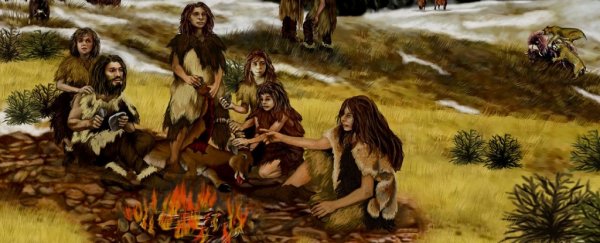The more we learn about our evolutionary history, the more it seems like early humans and Neanderthals just couldn't keep their hands off one another.
A new study has once again found evidence that a long, long time ago, our ancestors made a habit of intermingling with Neanderthals - not once, not twice, but time and time again, in several different locations.
As our ancestors made their way out of Africa and through Europe and Asia, it seems they unknowingly weaved traces of other human species into our modern genome.
Analysing the DNA of hundreds of people with Eurasian ancestry, researchers have found genetic material linked to Neanderthals in the Altai mountains of modern Siberia - an entirely different lineage from the Croatian population of Neanderthals identified in past genomic research.
"It's not a single introgression of genetic material from Neanderthals," says biologist Omer Gokcumen from the University at Buffalo.
"It's just this spider web of interactions that happen over and over again, where different ancient hominins are interacting with each other, and our paper is adding to this picture."
It's only recently that we've come to realise just how much of our evolutionary history is filled with interspecies sex.
Fresh archaeological discoveries and modern genomic research has found that rather than simply replacing other competitor species, like Neanderthals and Denisovans, Homo sapiens actually interbred with them.
And that's not necessarily a bad thing, either. In fact, there's evidence to suggest that our Neanderthal DNA helps to protect us from viral epidemics, which seems oddly comforting given the times.
Today, most modern humans still have a little bit of Neanderthal hiding in their genes, even those who come from the epicentre of humanity. Just this year, a new method for analysing our genomes revealed modern African populations, who were once thought to be Neanderthal-free, also contain a mixed heritage in their genome.
For years, it was assumed that this tiny dose of DNA - usually around 2 percent - was linked to a brief encounter thousands of years ago between our species and another. Growing evidence, however, makes that scenario far less likely. Instead, it appears this was a frequent love affair.
"It seems like the story of human evolution is not so much like a tree with branches that just grow in different directions. It turns out that the branches have all these connections between them," Gokcumen says.
The sheets have been crinkled and it's going to take us a while to iron out all the details. Gokcumen says that every ancient genome we sequence will bring with it a new perspective and he's more than excited about that prospect.
In this case, his team's research has not only isolated variants at a single shared nucleotide level between us and Neanderthals, it also reveals a large deletion of genetic information shared with both Neanderthal lineages - a variant that hasn't been found before.
In the end, the authors conclude that the Altai Neanderthal lineage "represents the ancestral lineage of Neanderthals and was sampled only in Asia and late Neanderthals", while the other lineage "replaced the ancestral Neanderthal lineage in Europe ~50,000 years ago."
Together, these results suggest that in the far distant past, ancestors of East Asians and Western Europeans intermixed with different Neanderthal lineages on multiple occasions as they spread out of Africa.
"The picture in my mind now is we have all these archaic hominin populations in Europe, in Asia, in Siberia, in Africa," Gokcumen explains.
"For one reason or another, the ancestors of modern humans in Africa start expanding in population, and as they expand their range, they meet with these other hominins and absorb their DNA, if you will.
"We probably met different Neanderthal populations at different times in our expansion into other parts of the globe."
The study was published in Genetics.
